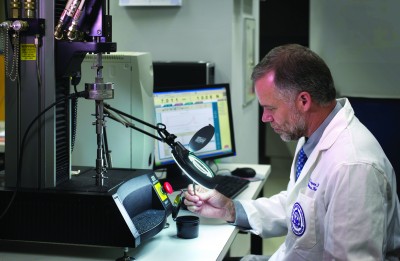NSU Newsroom
SharkBytes
Horizons
This version of NSU News has been archived as of February 28, 2019. To search through archived articles, visit nova.edu/search. To access the new version of NSU News, visit news.nova.edu.
This version of SharkBytes has been archived as of February 28, 2019. To search through archived articles, visit nova.edu/search. To access the new version of SharkBytes, visit sharkbytes.nova.edu.
NSU Dental Professor Receives U.S. Patent for Developing New Bonding Technology
Over the past several years, dentists have shifted from metal to ceramic materials like zirconia for crowns, implants and other devices due to enhanced esthetics and biocompatibility. One downside of zirconia is that it does not bond well with other synthetic or natural substances due to its chemically non-reactive nature, making it difficult to achieve long-term success in clinical applications.
Jeffrey Thompson, Ph.D., professor of prosthodontics and director of the Biosciences Research Center in Nova Southeastern University’s (NSU) College of Dental Medicine, and a team of researchers from RTI International in Durham, N.C., recently secured a U.S. patent for developing a surface modification technology to promote chemical bonding between high-performance ceramic materials like alumina and zirconia and biological materials, like tooth structures, and synthetic materials, like dentures and crowns.
The method utilizes a chlorosilane precursor to produce a very thin layer of silica on the inert ceramic surface. This allows traditional adhesive approaches and adhesives to be used in clinical bonding procedures with a high probability of a durable bond.
“Zirconia is like Teflon®, so getting it to bond with anything is a challenge,” said Thompson. “Chlorosilane is one very promising solution to the problem of adhesive bonding of zirconia products in the adhesive dental field. It also could have implications in other medical and non-medical fields,” said Thompson.
The title of the patent is “Surface modification for enhanced silanation of ceramic materials” (U.S. patent 8617704).
The research was funded by a National Institutes of Health (NIH)/National Institute of Dental and Craniofacial Research (NIDCR) grant.
“Nova Southeastern University is committed to research with practical applications, and we are proud to partner with leading research organizations like RTI to develop solutions for the field of dentistry, that could also have implications in other medical and non-medical arenas,” said Gary S. Margules, Sc.D., NSU vice president for research and technology transfer.
Thompson joined NSU’s College of Dental Medicine in 2007. He previously served as professor and graduate program director of the Department of Biomedical Engineering at the University of Texas-San Antonio from 2005 to 2006. Before that, he was an associate professor of operative dentistry and biomedical engineering at the University of North Carolina-Chapel Hill for 10 years. He graduated from the University of Florida in Gainesville with a Ph.D. in materials science and engineering in 1995.
Thompson has published 135 papers and book chapters and is a fellow of the Academy of Dental Materials. He is also a former president of the Dental Materials Group of the International Association of Dental Research.
